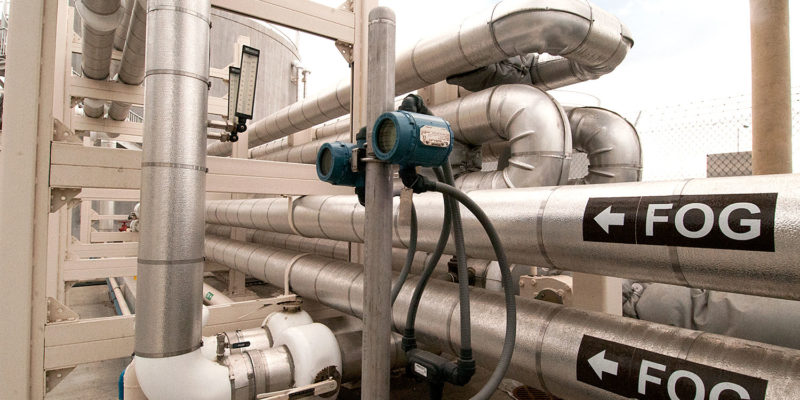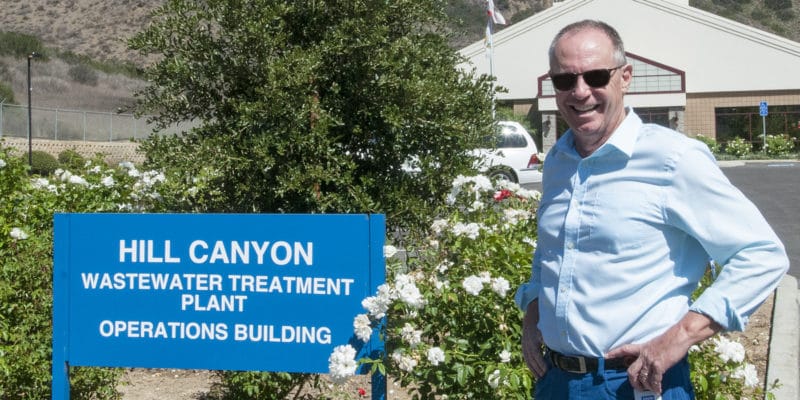Coverage of biosolids and co-digestion supported by Anaergia
East Bay Municipal Utility District

Pipelines at EBMUD’s grease and high-strength organics receiving system.
Waste Received: fats, oil and grease (FOG), poultry blood, food waste (e.g., dairy, winery, brewery), cheese waste and more
Stats: plant receives a total of 100 trucks per day, or 500,000 gallons per day – about 40% of this, or 200,000 gallons of high-strength waste, goes to the digesters, remainder goes to plant headworks
Facilities: three receiving areas designed for each type of waste; storage tanks; heat exchangers; recirculation pumps; metering pumps; TruckTrack monitoring software
Started-up: Resource Recovery began in 2002. New receiving area started in 2014.
What Works
1.) Long-term customers provide great value – EBMUD has found partnerships with their customers and good customer service maintains a steady flow of the right types of waste. FOG, proteins, and Beverage wastes are high energy
2.) TruckTrack Software – EBMUD developed their own software package to efficiently monitor and process all of their deliveries by their customers. Designed with internal resources the software controls security access, tracks delivery information and automates billing.
3.) Trash removal – EBMUD’s new unloading area uses a static bar screen trough which captures large objects which could damage pumps. The trough is cleaned by the in-plant Vactor truck once a month. Further downstream Rotacut macerators and Mu n Monster grinders are used for size reduction and pump protection. In the food waste receiving area – peristaltic pumps are used in the food waste receiving area because the waste sometimes has 2” solids. A paddle finisher is used to separate out trash from the food waste.
Lessons Learned
1.) Odor control is important – Even some wastewater operators struggled with the foul smells from certain grease and dairy waste. EBMUD continues to upgrade their odor control units and enclosed more of the waste receiving systems to minimize odors.
2.) Inline heat exchangers keep grease flowing – EBMUD installed heat exchangers to preheat grease and prevent lines from plugging.
3.) Stay away from woody waste – organic waste with strong cellulous or fibrous material, such as wood waste or tree branches, does not increase biogas production, passes through the digesters and increases the amount of biosolids that need to be hauled away.
4.) Find a customer for produced energy – EBMUD produces 140% of their electrical needs each day using the co-gen facility. The excess power is sold to the Port of Oakland under a long-term purchase power agreement and the Port uses all of EBMUD’s surplus.
“Our Board of Directors and community members are very supportive of this project. We’re recovering waste, turning it into a resource and we’re lowering greenhouse gas emissions. We keep moving into the future with this project. Our next phase will take our food waste receiving system from 8 tons per day to over 100 tons per day. Technology is advancing rapidly in this area and will help us resolve many of the challenges associated with food waste digestion” – John Hake, Senior Civil Engineer Resource Recovery Program
Oro Loma Sanitary District, San Lorenzo
Waste Received: grease and cheese waste
Stats: 10,000 gallons received per day
Facilities: receiving station; conical storage tank; Vaughn recirculation pump; Mono dosing pump; Waukesha engines with CHP facility
Started up: 2010
What Works
1.) Find and keep great customers – Oro Loma accepts waste from only two firms in order to manage the delivery schedule and meter waste into the digesters.
A local grease trap waste company delivers 1-4 trucks each day and calls ahead. The second company, a cheese production facility calls ahead and delivers on weekends to help balance the loads of high-strength waste.
2.) Rota-Cut (Vogelsang) Rock trap and grinder – grease is full of debris so Oro Loma’s first step is a combined rock trap, strainer and macerator. It settles out rocks and silverware while macerating rags into small pieces so the grease flows smoothly.
3.) Grease piping with plenty of flush lines – Oro Loma minimized the number of turns and elbows in their piping and added several flush water inlets so the grease line can be kept clear. The lines are flushed clean every weekend.
Lessons Learned
1.) Cheese whey can quickly upset a digester – operators learned cheese whey is like “rocket fuel” for biogas production but in Oro Loma’s smaller digesters it would sometimes upset them. With two, new
1.5 million gallon digesters they can now accommodate the cheese whey and boost biogas production.
2.) Customer quality control – loads vary greatly so find good customers and work closely with them to control grease quality and delivery times. Work hard at customer service to keep great customers.
3.) Conical storage tanks work best – using a steel, 15,000 gallon conical storage tank has worked best as it concentrates grit and other debris in the lower section and makes it easier to flush out the storage tank.
“This is a win-win situation for us. We receive a tipping fee, and it is a benefit to producing gas to run our facility. The biogas is used to run our boiler and co-gen engines. The engines produce 750 kilowatts daily and the plant load is 850 kW. We have to be careful with this – we check our digesters carefully, we check gas production frequently. Overall this is a simple process, a simple design and it helps the District.” – Manuel Talledo-Garcia, Supervisor of Plant Operations
Hill Canyon Wastewater Treatment Plant, Thousand Oaks

Chuck Rogers, retired GM, Hill Canyon wwtp
Waste Received: grease, brewery and yogurt
Stats: 15,000-30,000 gallons received per day Facilities: receiving station; storage tanks; dosing and mixing system; dosing/gas monitoring software program; co-gen facility (privately owned and operated)
Started-up: 2007
What Works
1.) Outsource non-core functions–the co-gen engines are owned and operated by CHP Clean Energy under a 15-year public-private agreement. Energy is sold back to the treatment plant at a below market rate. A great option for facilities that want co-gen and cheap electricity, but don’t want to invest precious capital or develop the significant skills necessary to run it properly.
2.) Use a business like approach–be sure there is a viable business plan for the time and energy your team will invest in a co-digestion project and the potential payback. There is increasing competition for high-strength organics; haulers have more choices for disposal these days. There’s also good grease and bad grease. Hill Canyon found yogurt whey, beer waste and residuals from biodiesel production are great gas producers.
3.) Automation and optimization–Early on Hill Canyon struggled with dosing the grease and controlling the resulting bursts of biogas. They contracted with a local software company to write a script that monitored gas production and dosed the grease waste to prevent spiking or dips in biogas production that would affect co-gen engine performance.
Lessons Learned
1.) Grease is nasty stuff full of debris–they started-up their first receiving station and instantly found it was ineffective at removing rocks and debris from the grease. Hill Canyon is now installing an extended rock trap with an automated screening system.
2.) Grease receiving is labor intensive–operators were required to stay with trucks as they unloaded to prevent problems from occurring. Maintenance needs were higher than expected. Hill Canyon is installing the new automation to ensure the receiving station can be unmanned.
3.) Does this make business sense – costs of running the receiving station are higher than expected. Tipping fee revenue can be volatile; receiving is labor intensive; some sources of grease can generate strong odors or have limited gas production value.
“Would we do this again? I’m not so sure. We have always focused on conservation and overall facility optimization as critical elements of our energy program. I would advise others to be careful what you wish for. It’s definitely helped us to reach goals of 100% onsite renewable generation, and we created a viable and profitable business, but it was not without its significant challenges. I would recommend a do it yourself approach relying on the skills of your Operations and Maintenance teams. I give full credit to my staff for making this work. We learned over time, our success today is built on the resiliency of a staff that wouldn’t accept failure. If it was easy, everyone would be doing it.” – Chuck Rogers, Plant Manager (retired)